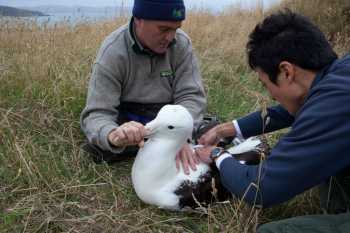Lyndon Perriman is the New Zealand Department of Conservation Head Ranger for the mainland breeding colony of Endangered Northern Royal Albatrosses Diomedea sanfordi at South Island’s Taiaroa Head. His latest report on the 2016/17 season now underway shows the careful hands-on management this mainland colony receives.

Lyndon Perriman (left) and Junichi Sugishita get hands on with a Northern Royal Albatross at Taiaroa Head, photograph by Keith Payne
“35 nests and I think that is all we can expect for the 2016/17 season (we generally get around the mid 30's each year, a number that is growing, albeit slowly). This includes two female-female pairs, each have laid one egg giving us a total of 37 eggs laid.
Today I candled many of the eggs with a torch and could see that almost all the eggs I looked at today were fertile, including our webcam pair (BK/RBK nest) The only infertile eggs that I've found (from the 30 candled today) were three of the four laid by the two female-female pairs.
These extra eggs were in the incubator until they were old enough to determine fertility and one of these in the incubator was fertile so it has been placed back under one of its mums at the nest (as she was still present incubating their other egg). Their other egg was infertile so it was removed before the fertile egg was placed back at the nest.
Both eggs from the other female-female pair were infertile so they too have been removed from the incubator. They failed to make an actual proper nest this season, so that pair can't be used as foster parents this season, but they have raised foster chicks in previous seasons. I think the problem this year was choosing a nest site very close to another pair and while these two females were out at sea the male of the next pair has taken guard of the area, not allowing the female-female pair actually to get back to their site. One laid the egg on a sloping hill, the other nearby in a poorly formed nest that she started making the day before she laid her egg.
On a sadder note, we have seen an albatross dead at the bottom of the cliff, presumably an accidental clipping of the cliff or sudden loss of wind as it was coming in or leaving the headland in recent days. It is in an area that requires boat access and that won't occur for some time as it is also in a fur seal breeding colony, making recovery of the body more problematic (fur seals become very territorial of their breeding grounds over November and December and charge people rather than flee when in full breeding mode).
We have spied a green band on its leg, so we have narrowed it down to one of 14 birds seen this season with a green band, that we haven't seen over the last few days (seven breeding birds and seven adolescent birds), so if you see any bird with a green band via the webcam, take a screen shot of it (if the webcam plays nicely) and let us know, thanks.
While it is a loss, it is a natural event and populations can withstand these events. It’s all the other non-natural things like introduced predators and pests that cause major issues for this and other species.
Today we saw bird number 100 and 101 for the 2016/17 season. The remaining eggs will be candled next week.”
Watch a recent video clip featuring Lyndon Perriman discussing the current breeding season and read more in ACAP Latest News about Taiaroa Head’s albatrosses here.
John Cooper, ACAP Information Officer, 24 November 2016

 English
English  Français
Français  Español
Español